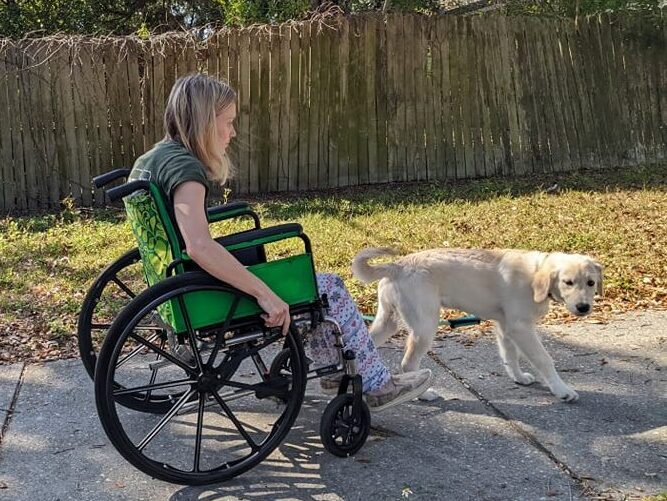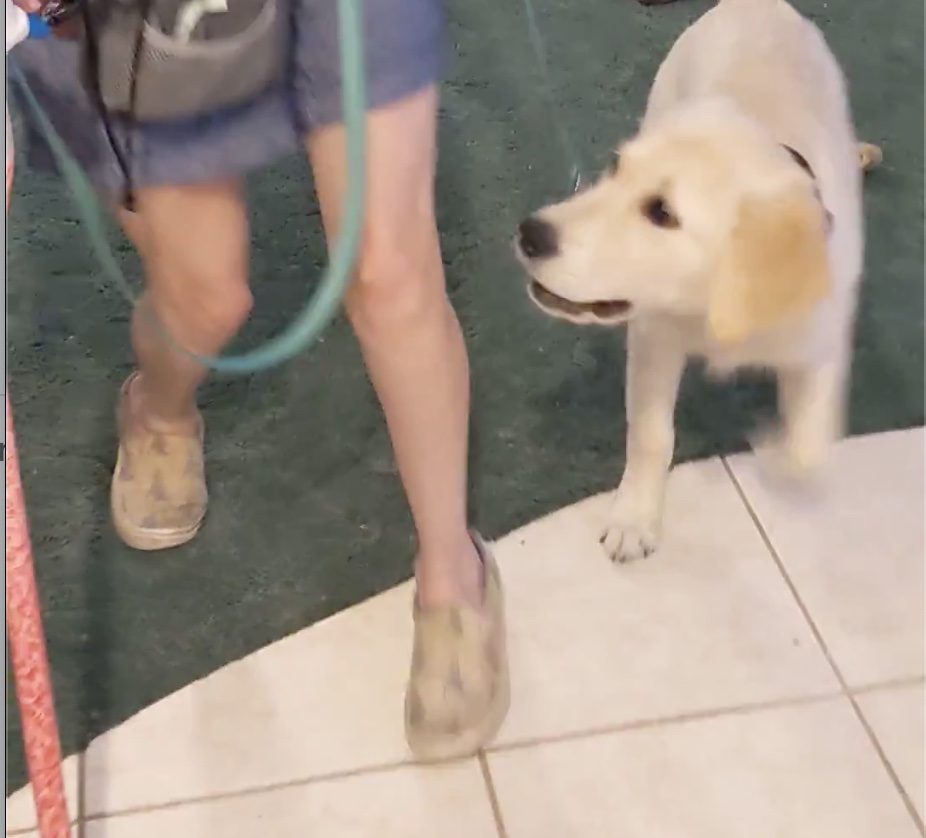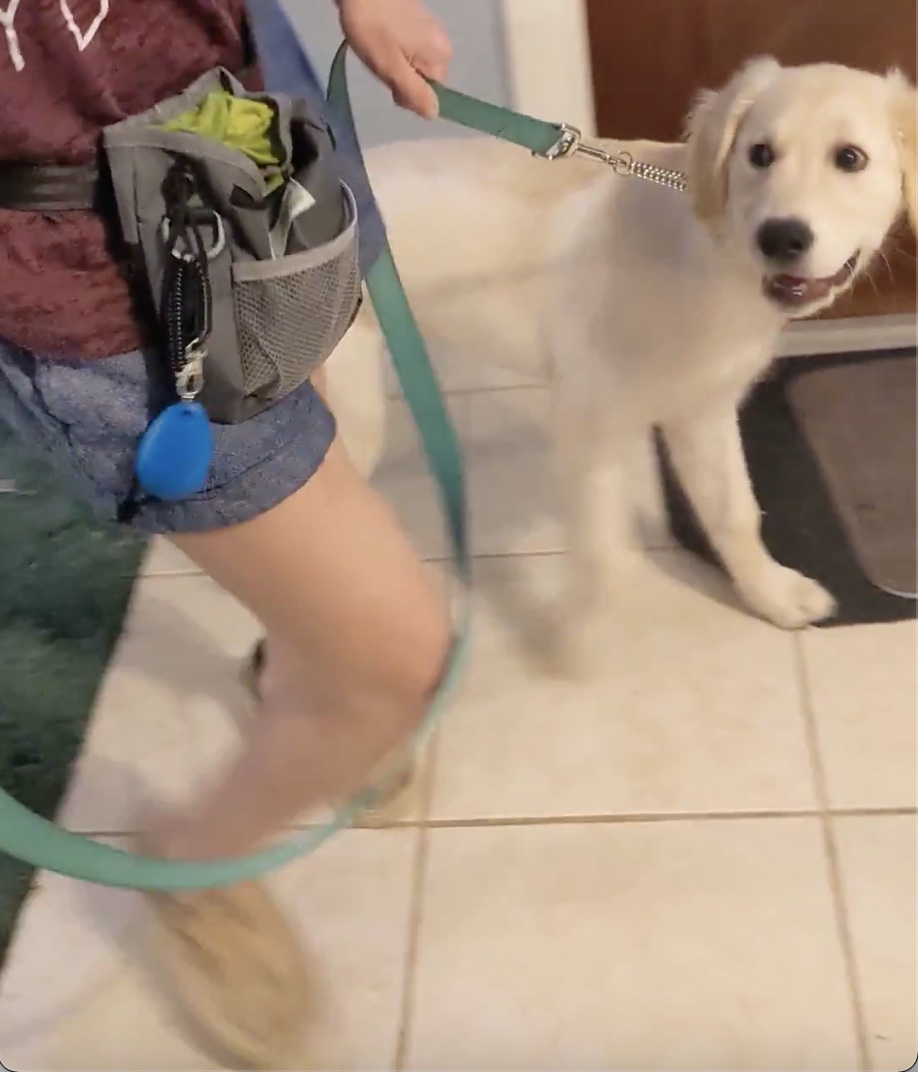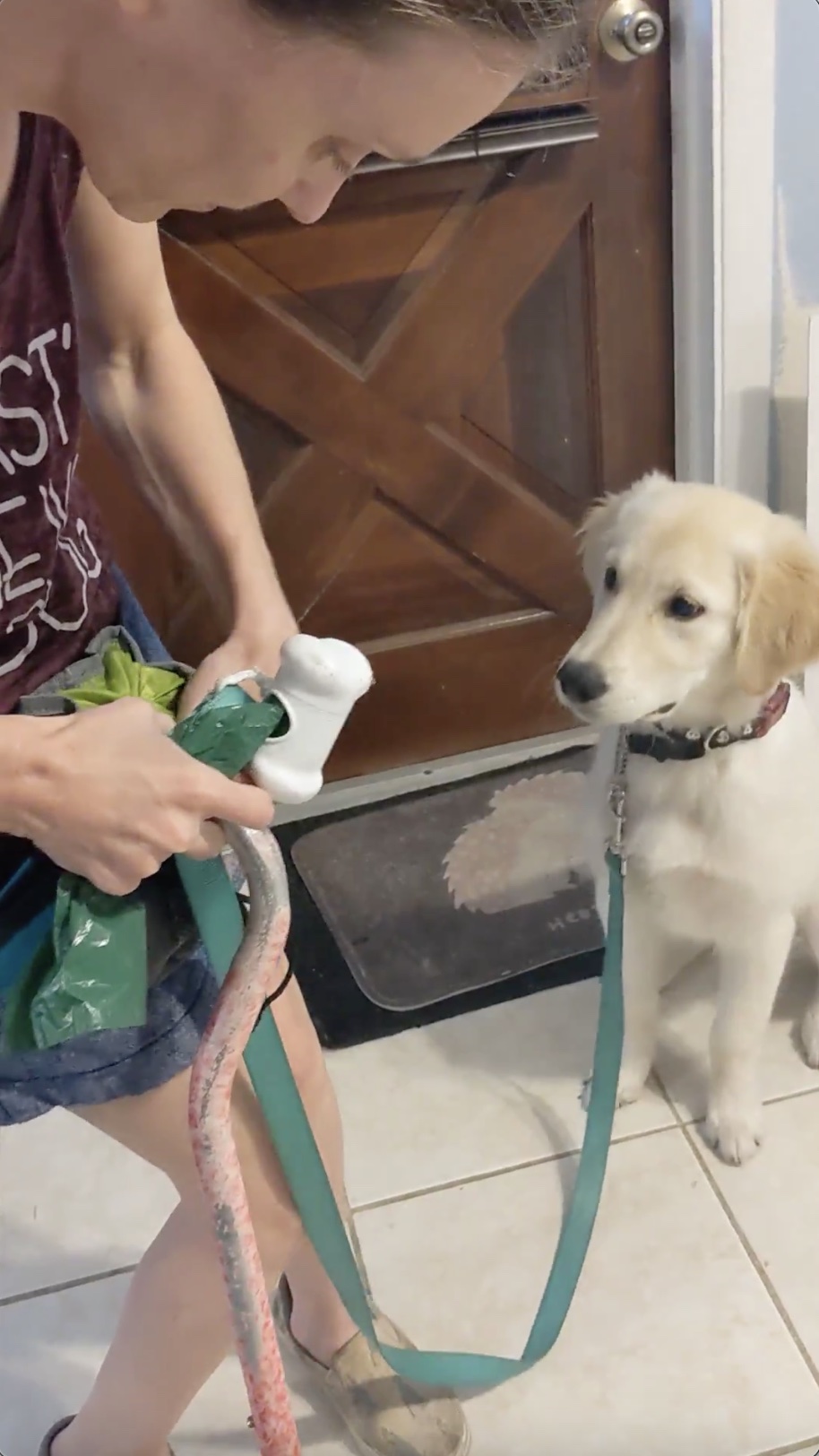Adapting service dog training
People with disabilities, whether physical or psychological, are accustomed to work arounds in every aspect of life – adaptations or modifications that empower us to accomplish our goals despite whatever limitations we may experience. ELLAS Animals INC specializes in teaching people with disabilities how to train their own service dogs, and this necessitates a fluid approach, adapting service dog training to a trainer’s disability. Today’s guest blogger, Katie Calahan, shares her experience beginning with a new puppy and how she is learning to modify the training techniques to ensure she and her puppy can achieve success on their journey to become a service dog team.
Adaptations & Gravity – by Katie Calahan

A year of change
In a calendar year, we lost our almost 18 year old cat that my husband had when I met him, our oldest left for college, and our 9 year old Golden Retriever, Leeloo, passed away. It was a lot of change and grief, but I had trained Leeloo, in an unofficial capacity, as my service dog. We belonged to each other in the beautiful and complex way two interdependent creatures truly do. When she left us, my grief was immeasurable. She was an incredible dog.
My knee jerk response to the idea of getting another dog was that it was unthinkable. First, no dog could ever live up to my amazing Leeloo, and second, I thought potty training another dog would kill me. I was born with Cerebral Palsy, a neuromuscular disorder, and I’m almost 40 now so the physical demands seemed impossible. I declared I “wasn’t ready.”
A new puppy
Famous last words! In early December I saw an 8 week old golden retriever puppy who was currently being called Katie, which is my name. I had to meet her and, well, the rest is history! We re-named her Daisy, and friends and relatives expressed how glad they were that we got a new dog because “she’ll have the best life.” We have a lot of love to give in my house for sure, but more than that I was invested in taking the journey to have an official service dog this time.
Adapting service dog training
I started with the ELLAS Animals INC Puppy Basics course, and it was obvious from the beginning of potty training that I was going to have to make adjustments or, more accurately, adapt. I am a petite person with a physical disability so if the puppy books, internet articles, or training experts insist you pick the puppy up and put them out in the same corner of the same yard, that just isn’t going to be how it happens. I did everything in my power to get the dog out on our established schedule (that I tracked on the ELLAS template), rewarded every time she went potty outside, and stayed as consistent as possible with yard location. I reached out to ELLAS when there was regression and was reassured Daisy and I have to do what works for us. Yes, we successfully potty trained and completed our Puppy Basics course.

Formal training
We recently started the journey of training a service dog with the ELLAS Animals INC Foundational Obedience course. Daisy and I had a routine of walking my daughter to her bus stop and back in the mornings. It’s a short but pleasant walk as her bus stops between a park and a school so there are always kids, dogs, birds, you name it. However, I had two weeks of work that meant very late nights and physical exhaustion for me. Those two weeks we skipped the morning walks. We kept our neighborhood walks in the afternoon, which are much quieter, and Daisy seemed to be really getting the hang of things. I decided it was time for morning walks again after she slept, not just soundly, but slept late without her usual early request to go potty. She was bursting with energy and her afternoons walks were great.
Gravity
I didn’t think about how much bigger my 5 month old girl was now or how very many distractions we would have to contend with. It started off well enough; she was zig zagging and smelling everything, but moving along. We got to the bus stop and I let her explore a little circle around where we were standing by letting out the leash a bit. Then a huge gust of wind took the pile of leaves in front of Daisy into the road and she lunged hard. I was surprised, but I had the wherewithal to drop to my knees (to prevent a full-out fall and to ground me to use my upper body strength). I pulled back on the leash and prevented Daisy from following the leaves into the road, but in the process, I dragged my hand across the sidewalk hard enough to be dirty and bleeding. I gave her a sit and stay command and she obeyed.
On our walk back, I was distracted by my sore knees and injured hand and I did not see the parade of children on bikes approaching from behind me. Daisy lunged again and I fell, without releasing the leash. I sat and scooted close enough to Daisy to hook my fingers into her collar and commanded her to sit. She obeyed and I remained sitting next to her on the sidewalk, giving verbal corrections every time she reacted to the bikes. When they were safely past us, I commanded her to stay. I got to my feet and when I was ready, we walked on. When we reached the corner where we needed to cross the street, it was full of kids, so I commanded a sit and we waited. We got home without any other issues, and it was amazing how calm she became when we got to the calmer part of our walk without distractions.
Down but not out
I felt discouraged because I knew from my Introductory Mini Course before the ELLAS Animals INC Foundational Obedience course not to increase Difficulty, Distraction and Duration (the 3 Ds) at the same time. I had taken her on a longer walk with an extreme level of distraction. I reached out to ELLAS that day and was reminded again that Daisy and I need to find the way it works for us. It was reaffirmed I’d done too much too fast. Lunging and pulling are usually corrected with “heel”, but ELLAS recommends in Lesson One of Foundational Obedience that you start in your living room where there’s no distraction.




Adapting service dog training
The next day I prepared myself for the morning walk by ditching a shoulder strap purse for a treat bag on my waist, reinforced her sit/stay at the door a few times so that I was leading and mentally prepared for an overstimulated puppy. She did great, even though she had no idea what heel was, but she responded much faster to my verbal commands and corrections. I decided to continue having her sit and wait at the corner before we cross the road like she does at the front door. On the other side of the crosswalk a jogger paused and watched me command a sit and reward Daisy. I told the jogger she could pet Daisy as her work was done now and the jogger rushed to give Daisy some affection. I thanked her for waiting for permission and she said “Aren’t you afraid? That she’ll pull you over?” and I said, “Oh, she has, but we’re working on it.”
Guest Author – Katie Calahan: I’m an actress/writer/director and run a local children’s theater program. I received my classical training and my BFA in Theatre Studies from Boston University. I’m a native Floridian (We DO Exist!), but I’ve lived in Boston, New York, Dublin and LA. I’m currently based in the good old sunshine state, but more than happy to travel. I love an adventure! I love Shakespeare, dessert, kayaking, Bob’s Burgers, a great book, Disney and my golden retriever!

End Note: Since her walk with two falls, Katie has implemented several adaptations to her Foundational Obedience training. As she mentioned, she has made adjustments to her training equipment that will allow her more control and to keep her hands free for the leash and her cane. She takes some extra time to get her puppy’s brain turned on before heading out the door. She mimics this same routine at each intersection, which is installing an automatic sit-stay to regain complete control before crossing roads. Katie is also structuring her routine so that she practices heel inside the house with fewer distractions to build a solid foundation as well as outside the house where she alternates training heel while walking with her cane and using her wheelchair. She has started working with a dog walker who is interested in learning the training techniques from our program so she can reinforce Daisy’s training while getting more exercise on longer and faster walks.
Nothing in ELLAS Animals INC’s website or blog is intended as medical, legal, or financial advice. We receive no compensation for recommendations or reviews.
